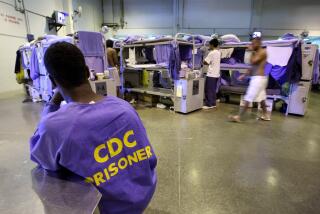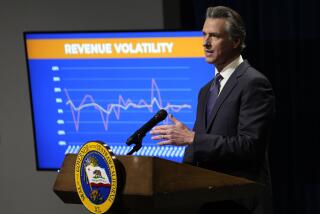Wilson Proposes 15% Tax Cut, More Money for Schools
- Share via
SACRAMENTO — With the state awash in new tax revenue, Gov. Pete Wilson on Wednesday proposed a $61.5-billion budget that includes a 15% income tax cut, pumps more money into schools and prisons, and calls for an ambitious public works construction program.
Wilson again is proposing deeper cuts in welfare, and is making trims in several departments responsible for environmental protection. But with more Californians working and paying taxes, Wilson’s budget includes a significant reserve--$400 million, up from the paltry sum of less than $30 million in the current budget.
“This budget sets public safety and public education as the top priority,” Wilson said as he released his sixth budget, but the first issued at a time of sustained economic growth. “It proposes new steps to continue improving our state’s job climate.”
Wilson said his across-the-board 15% tax cut for individuals, businesses and banks would boost the economy, as would his plans to ask voters to approve nearly $8 billion in bonds for public works projects, ranging from new schools and prisons to environmental improvements.
In addition to the income and business tax cut phased in over three years, Wilson is proposing 10 narrow tax cuts and tax credits aimed at boosting specific industries such as computer manufacturing and biotechnology. Altogether, the tax cuts would total $10.8 billion spread over the next four years.
The budget’s release marks the start of the annual battle over how the state will spend its billions. If recent history is any barometer, the process will drag past the state constitutional deadline of July 1 for approving the spending plan for the 1996-97 fiscal year. The governor signed the current fiscal year’s $57-billion budget into law on Aug. 3, 34 days past the deadline.
In addition to attacks from Democrats, Wilson will probably be challenged this year by antiabortion Republicans who want to cut off some or all of the $40 million the state spends on abortions.
Wilson, who supports abortion rights, made no effort to appease the antiabortion forces in his budget, saying the California Supreme Court has required that the state fund abortions for poor women so long as it pays for other pregnancy services.
“If they wish to challenge it [in the courts], fine,” Wilson said.
“Does it look like the governor is listening to us? I would have to say no,” remarked state Sen. Ray Haynes (R-Riverside), one of the Legislature’s leading antiabortion lawmakers. “Does that mean he won’t? The next six months will tell. . . . We are expecting something.”
While several Democrats decried parts of the budget, Senate President Pro Tem Bill Lockyer, the leading Democrat in the coming budget negotiations, was muted, saying his first reading shows “large, large areas of agreement.”
State Supt. of Public Instruction Delaine Eastin called the governor’s proposal an opening shot, but one that “is the best I’ve seen in the last nine years.”
Orange County officials had not yet analyzed the governor’s budget, but they said Wednesday they were cautiously optimistic that it would have no detrimental effect on the county’s finances.
“Generally, it’s good news for the county,” Supervisor Marian Bergeson said. “But I think it’s going to take more scrutiny.”
She said the county is particularly interested in reviewing its share of the funding for trial courts and social services programs. County department heads have been asked by Chief Executive Officer Jan Mittermeier to study the effects of the governor’s budget and report back with their analysis early next month.
“At first blush, there is nothing that appears totally onerous,” county analyst Robert Wilson said. “But we have not received the governor’s budget in detail yet. The impacts on the county right now are impossible to say.”
The governor’s budget also was greeted cautiously by city officials in Orange County, who vividly recall how the state two years ago siphoned off a huge block of money originally intended for the municipalities to balance the state’s books.
“I felt pretty comfortable all along that they weren’t going to tap the cites or counties,” Westminster Mayor Charles V. Smith said. “I’m pleased it’s not the disaster of years past. Now I would hope that they’d return some of the money they’ve taken in years past. But I suspect the chances of that happening are not too good.”
On the schools front, county educators were cautious but hopeful that the governor’s budget proposal will provide a windfall for grades K-12.
“We’ve done a lot worse than this in the past,” said Michael B. Kilbourn, special services director for the Orange County Department of Education. “But it’s difficult right now to really say how it’s all going to fall out in the end. I’m extremely cautious right now. I don’t know if we could put a happy face or a sad face on it until we do a full analysis.”
In his budget, Wilson returned somewhat to his moderate beginnings, earmarking money to several new prevention and education programs, ranging from $5 million for an anti-domestic violence campaign, $5 million for creation of a state-funded experiment with all-boy and all-girl schools, and another $20 million for contraceptives for the working poor.
In another major proposal, Wilson hopes to put more police on the street, at a cost of $150 million. To pay for it, Wilson needs legislation allowing taxpayers to dedicate 1% of their income taxes for local law enforcement.
The budget includes several familiar refrains in addition to the tax cut proposal. Wilson is renewing his call for construction of at least six new state prisons by asking lawmakers for the third year running to place on the ballot a bond for prison and jail construction. This year the proposal is for a $2.2-billion measure in November.
The main focus of the coming budget battle, however, will probably revolve around Wilson’s tax cut proposal, the same one killed by Senate Democrats last year.
Wilson as a presidential candidate last year vowed to take the tax reduction to voters in a ballot initiative. On Wednesday, he acknowledged that he will not pursue the tax cut by an initiative and will instead push for approval in the Legislature.
While he said he was optimistic about his chances, Democrats and others voiced opposition.
Eastin, for one, said the tax cut would eliminate about $5 billion in money for public schools over the next five years. Lockyer did not rule out a tax cut, but said he favors targeting cuts to specific “growth-inducing, job-creation” activities.
Assembly Democrats were more direct.
“It’s going to make the Gingrich-Clinton act look like child’s play,” said Assemblywoman Marguerite Archie-Hudson (D-Los Angeles). She charged that Wilson’s budget does nothing for Los Angeles County and other urban areas.
California is hoping for more than $600 million in federal money for health care and prison costs related to illegal immigration, and for changes in welfare requirements that would permit welfare reductions worth $1.2 billion. The entire $8-billion bond package depends on voter approval. And several other parts of the budget require legislation in Sacramento.
The plan for the state’s 1996-97 fiscal year anticipates a $2.2-billion increase in tax revenue because of the state’s improving economy. But while Wilson and his finance director, Russell Gould, said California’s economy continues to mend, some others were skeptical about the forecasts.
“I question whether there’s going to be a billion-dollar surplus,” Democratic state Controller Kathleen Connell said. “I don’t think California is yet out of fiscal danger.”
The total proposed budget is $58.57 billion, plus another $3 billion needed to pay off various bonds. Excluding the bonds, which vary widely from year to year, the budget increase amounts to 2.4%. What follows are proposals for some specific areas:
EDUCATION
Wilson’s budget allocates $24.3 billion for public education, from kindergarten through the universities. For kindergarten through 12th grade, he proposes spending $17.8 billion, translating to annual per-pupil spending of $4,544, up from the current $4,500 per child.
The schools would receive about $1.7 billion more than they got this year, including about $400 million in one-time money for improving reading and math instruction, buying more computers, setting up single-sex academies and other projects.
Higher education would receive $848 million above this year’s level, for a total state expenditure of $6.5 billion. Wilson’s budget includes no fee increases at the University of California, the California State University system or the community colleges.
The governor also is pushing for voter approval in March of a $3-billion school construction bond, including $975 million for building at universities and colleges.
PRISONS
The budget for California’s prison system for adults and juveniles would increase to $4.25 billion, a 10.8% hike.
Spending on prisons for adult felons would go up to $3.7 billion. That represents a 20% jump since the Legislature approved the “three strikes” sentencing law two years ago.
Wilson also is renewing his push to place on the November ballot a prison construction bond. The Legislature has refused his request for the past two years.
ENVIRONMENT
Wilson’s budget shaves $50 million from various environmental protection programs and resources agencies, spread over departments ranging from the Air Resources Board to the Department of Pesticide Regulation.
While Wilson is not cutting any major program, he is calling for the elimination of some jobs throughout the various environment-related agencies.
The governor wants to spend an additional $16.4 million on state parks, but also is raising fees by relatively modest amounts for camping in some of the facilities.
The governor is proposing that the Legislature place on the November ballot a $540-million bond measure that would pay for improvements in the Sacramento-San Joaquin River Delta and local sewage waste water treatment.
WELFARE
The governor is proposing a $225-million cut in welfare, amounting to a 4.5% reduction in cash grants to indigent families. If the cuts are approved, California’s welfare grants would be the ninth most generous in the nation, he said.
Wilson plans to begin negotiations next week with legislative leaders on a key budget issue--permanently abolishing state law passed decades ago that guarantees welfare recipients automatic annual cost-of-living increases.
Wilson warned that if lawmakers refuse, such increases for welfare recipients would add $1.7 billion in costs to the proposed budget, a sum that would “savage health care and education.” Lockyer and other Democrats are opposed to abolishing the law.
Wilson won approval for $395 million in welfare cuts last year. But that cut remains little more than theory. The federal government has not approved the 1995 welfare reductions, and lawsuits have blocked 1994 cuts. Currently, a welfare mother with two children receives $607 a month.
Times staff writers Carl Ingram, Richard Lee Colvin, Bill Stall, Matt Lait and Eric Bailey contributed to this report.
More to Read
Get the L.A. Times Politics newsletter
Deeply reported insights into legislation, politics and policy from Sacramento, Washington and beyond. In your inbox twice per week.
You may occasionally receive promotional content from the Los Angeles Times.










